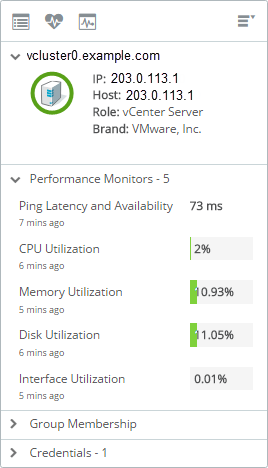Managing and Assigning Monitors
After you Promote Discovered Devices to managed devices, you can:
|
Monitor Summary Status |
|
Tip: To assign specific monitoring schedules directly to a device role, see the section titled Device Role Settings.
View Monitor Setup
To view the Monitor Setup Page for a device:
- Select a device on the My Network Map.
The Device Properties Card displays.
- On Device Properties, click Device Monitor Setup (
 ).
).Monitor Setup displays with current monitor setup.
Delete Multiple Monitors from a Single Device
To bulk delete monitors from a single device:
- Select a device from My Network Map.
The Device Properties Card displays.
- On Device Properties, click Device Monitor Setup (
 ).
).Monitor Setup displays with current monitor setup.
- Click on multiple rows in the Monitor Setup table (select either by CTRL+click, shift+click).
- Click the Delete (
 ) button.
) button.The selected monitors are deleted from the device.
Turn on/off Monitors for Multiple Devices
- Select one or more devices on the My Network Map or the collapsible device grid.
- Switch monitoring for a single monitor type On or Off by either:
- Single Device. From the Device Card, click Device Monitor Setup (
 ). Then select the monitor switch On/Off
). Then select the monitor switch On/Off  ).
). - Bulk Apply. Select devices individually (press and hold Ctrl and click on each device icon to select) or use bulk select
 ). Then use Bulk Apply
). Then use Bulk Apply  ) to select the monitor you want to switch On/Off
) to select the monitor you want to switch On/Off  ).
).
- Single Device. From the Device Card, click Device Monitor Setup (
Assign Additional Monitors
You can assign new or existing monitors to a device.
To assign monitors to a device:
After you have created monitors based on monitor library types, you can assign them to your managed devices.
- Select one or more devices on the My Network map or the collapsible device grid to access the Monitors window.
- From the monitors (
 ) panel, select the monitors you want to apply, and click the Apply to selected devices button.
) panel, select the monitors you want to apply, and click the Apply to selected devices button.
To add a new monitor:
You can add new monitor instances to the monitor library based on an existing monitor or 'built in' monitor type.
- Click the 'add' (
 ) button, choose a monitor type, and configure it.
) button, choose a monitor type, and configure it. - Assign your monitor to a device, many devices, or a device group.
- Switch On/Off the monitor. (For example, some monitors are switched Off by default.)
About Monitor Types
WhatsUp Gold provides active, passive, and performance monitors.
 Active Monitoring. Active polling, measurements, and user simulation.
Active Monitoring. Active polling, measurements, and user simulation.
 Passive Monitoring. Monitoring that does not generate network traffic.
Passive Monitoring. Monitoring that does not generate network traffic.
 Performance Monitoring. Historic device availability and resource capacity usage.
Performance Monitoring. Historic device availability and resource capacity usage.
